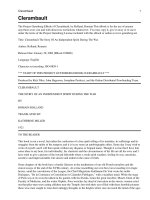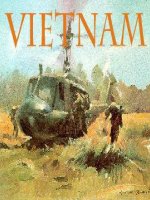The vietnam war an overview
Bạn đang xem bản rút gọn của tài liệu. Xem và tải ngay bản đầy đủ của tài liệu tại đây (3.96 MB, 29 trang )
■
Essential Question:
–What were the causes &
consequences of America’s
involvement in the Vietnam War?
■
Warm-Up Question:
–?
The Vietnam War
■
During the Cold War, the U.S. was
committed to containing communism
– The U.S. was effective in limiting
communist influence in Europe
– But, the spread of communism in
Asia led the U.S. to become
involved in a civil war in Vietnam
– Involvement in Vietnam from 1950
to 1973 proved to be America’s
longest & most controversial war
America’s Commitment to Vietnam
Since 1887, France
controlled the colony
of Vietnam in SE Asia
By 1945, Communist
leader Ho Chi Minh led
a war of independence
for Vietnam
Truman & Eisenhower
feared the spread of
communism in Asia
(“domino theory”)
& sent aid to France
America’s Commitment to Vietnam
Ho Chi Minh gained
control of communist
North Vietnam
Vietnam won
independence in 1954
but was divided along
the 17th parallel
Ngo Dinh Diem became
democratic president
of South Vietnam
America’s Commitment to Vietnam
Ho Chi Minh’s
communist supporters
in the North were
called the Vietminh
In South Vietnam, a
group of communists
called the Vietcong
were formed to oppose
Diem & unify Vietnam
America’s Commitment to Vietnam
In 1963, Buddhist
“Strongly
in
our
mind
South
Vietnamese
monk Quang Duc
is
what
happened
in
President
Diem
led
a
immolated himself to
China
at
the
end
of
corrupt
government,
protest Diem’s regime
offered little assistance World War II, where
China was lost. We
to the poor, &
don’t want that.”
In 1963 President
oppressed
Buddhists
—JFK
Kennedy
recognized
Presidents
Eisenhower
After JFK’s
death in
Diem’s
assassination
Diem
had
lost
&that
Kennedy
supported
1963,
the
responsibility
led to chaos in
control
of
Vietnam
&
Diem
despite
his
for
Vietnam
fell
to
South Vietnam
gave
approval
for the
growing
unpopularity
Lyndon
Johnson
assassination of Diem
The Gulf of Tonkin Resolution, 1964
In 1964,
a North Vietnamese
gunboat attacked the
USS Maddox in the
Gulf of Tonkin
Congress responded
with the Gulf of Tonkin
Resolution which gave
Lyndon Johnson broad
powers to “defend
Vietnam at any cost”
The Escalation of the Vietnam War
In an effort to
contain the spread
of communism into
South Vietnam,
LBJ began sending
U.S. troops in 1965
By
1968,
over
500,000
In “Operation Rolling
U.S. soldiers
U.S.
Troops
Thunder,”
thewere
U.S.
fighting
in
Vietnam
in Vietnam
military began bombing
North Vietnam
Fighting the War in Vietnam
■
The goal of U.S. military was to
defeat the Vietcong & support
democracy in South Vietnam:
–But, the Vietcong lived among the
civilians in Vietnamese in cities
& villages (who is the enemy?)
–The Vietcong used guerilla tactics
to combat U.S. military superiority
–Jungles made fighting difficult
The U.S. military used a variety of
tactics to fight the war in Vietnam
The air force bombed
villages & supply lines
(Ho Chi Minh Trail)
The U.S. military used a variety of
tactics to fight the war in Vietnam
The military used napalm to destroy villages
& pesticides (Agent Orange)
Orange to destroy crops
The U.S. military used a variety of
tactics to fight the war in Vietnam
Soldiers were sent on deadly “search & destroy”
missions into the jungles to find the Vietcong
Despite
military superiority,
“Myoverwhelming
Lai
the U.S. could not win in Vietnam
Massacre”
& the
war became unpopular at home
1968
TV broadcasts reported body counts, atrocities,
Television
made
Vietnam
a “living
room
war”
declining
troop
morale,
& lack
of gains
in the
war
General Westmoreland & the Credibility Gap
“Vietcong
surrender
is imminent”
“There is a
light at the end
of the tunnel”
“The U.S. has never lost
a battle in Vietnam”
But, the military
continued to draft
more young men to
fight in Vietnam
The American public believed their was a
“credibility gap” between what the gov’t was
saying & the reality of the Vietnam War
The Tet Offensive, 1968
In 1968, the
Vietcong launched
the Tet Offensive
against U.S. forces
in South Vietnam
The attack was
contrary to media
reports that the
U.S. was winning
the Vietnam War
The Tet Offensive, 1968
The Tet Offensive
was a turning point
in the Vietnam War
American
President attitudes
Johnson
began
towards
to question
the war
changed
whether&the
anti-war
war
movement
could be won…
grew
…& LBJ announced
that he would not
seek re-election
“Johnson’s War”
Protesting the Vietnam War
Since 1965, U.S. troops had been in Vietnam…
but
height
of the
Vietnam
War
As 1968
morewas
menthe
were
drafted
into
the war,
the&
the year
the disastrous
Tet Offensive
larger
theofanti-Vietnam
protests
became
Protesting the Vietnam War
Students
protested the
killing of civilians
& the draft,
especially the large
numbers of African
Americans,
Hispanics, & highschool dropouts
Richard Nixon & the Election of 1968
LBJ’s decision not to run for re-election & the
assassination
of Robert
left theof
Republican
Richard
Nixon Kennedy
took advantage
divided for
the election
ofelection
1968
theDemocrats
divided Democrats
& won
the 1968
Nixon wanted “peace with honor” in Vietnam
Vietnamization
Nixon & National Security
Advisor Henry Kissinger
developed a plan called
Vietnamization:
gradually withdraw U.S.
troops & replace them with
South Vietnamese soldiers
But, Nixon really wanted a
“knockout blow” in Vietnam
& secretly sent U.S. troops
Cambodia & ordered
bombings of Laos
When Americans found out about
Nixon’s attacks on Cambodia & Laos,
it set off the largest protest in U.S. history
250,000 people, mostly
students on college
campuses, protested
the war & some
protests turned violent
4 students died when
the National Guard shot
into a crowd of violent
protestors at Kent State
University in 1970
Ending the Vietnam War
In 1973, the U.S. &
North Vietnam
agreed to a cease fire
& the U.S. withdrew
troops from Vietnam
In 1975, North Vietnam
violated the cease fire,
invaded South Vietnam,
& unified the nation
under a communist
government









